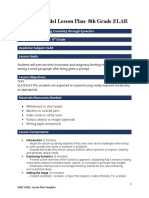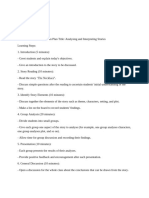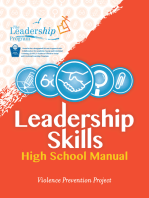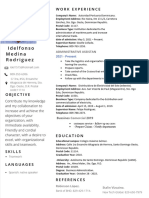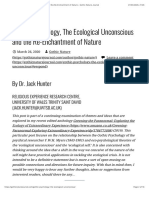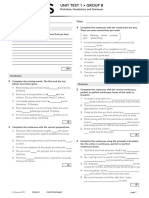Document
Document
Uploaded by
Lou BaldomarCopyright:
Available Formats
Document
Document
Uploaded by
Lou BaldomarCopyright
Available Formats
Share this document
Did you find this document useful?
Is this content inappropriate?
Copyright:
Available Formats
Document
Document
Uploaded by
Lou BaldomarCopyright:
Available Formats
Title: Brainstorming Research Topics
Objective: By the end of this lesson, students will be able to effectively brainstorm research topics for
their projects, considering their interests, relevance, and feasibility.
Duration: 45 minutes
Materials:
- Whiteboard/Blackboard or a digital presentation tool
- Markers or a digital drawing tool
- Sticky notes or virtual note-taking tools (optional)
Lesson Plan:
1. Introduction (5 minutes):
- Begin by explaining the importance of selecting a suitable research topic for any project.
- Emphasize that brainstorming is a creative process that allows students to explore their interests and
identify relevant and feasible research topics.
2. Discuss the Research Scope (10 minutes):
- Ask students to consider the subject or field they want to focus on for their research.
- Encourage them to think about the specific areas or aspects they find intriguing within the chosen
subject.
3. Brainstorming Techniques (10 minutes):
- Introduce various brainstorming techniques, such as mind mapping, freewriting, and clustering.
- Explain how each technique works and how it can help generate research ideas.
4. Engage in a Group Brainstorming Activity (15 minutes):
- Divide students into small groups or pairs.
- Provide them with a topic related to their subject of interest (e.g., climate change, technological
advancements, social issues).
- Instruct each group to use one of the brainstorming techniques to generate as many research topics
as possible within the given time frame.
- Encourage them to write down their ideas on sticky notes or use virtual note-taking tools.
5. Share and Analyze Ideas (5 minutes):
- Bring the groups back together and ask them to share the research topics they generated.
- Facilitate a discussion on the strengths and weaknesses of each topic, considering factors like
relevance, originality, and feasibility.
6. Individual Reflection (5 minutes):
- Ask students to reflect on the group activity and their interests.
- Instruct them to select one or more research topics they find most compelling and suitable for
further exploration.
7. Conclusion (5 minutes):
- Summarize the key points discussed during the lesson, emphasizing the importance of thoughtful
brainstorming for research topics.
- Encourage students to continue refining their chosen topics and seek guidance from instructors or
peers if needed.
8. Homework Assignment:
- Instruct students to write a brief description of their selected research topic(s) and why they find
them intriguing. This will serve as a starting point for their research projects.
Note: Depending on the complexity of the subject and the depth of exploration desired, this lesson plan
can be adjusted to suit the students' needs and time constraints.
You might also like
- You May Ask YourselfDocument19 pagesYou May Ask YourselfReccebaca100% (1)
- Touched - A Darkening AlleyDocument48 pagesTouched - A Darkening AlleyDave100% (1)
- Lesson Plan - Selecting An Appealing Topic For A Persuasive SpeechDocument3 pagesLesson Plan - Selecting An Appealing Topic For A Persuasive Speechaurimcr21No ratings yet
- Synectic LP FinalizedDocument2 pagesSynectic LP Finalizedapi-678247512No ratings yet
- 9 Alternatives To LecturingDocument8 pages9 Alternatives To Lecturingansari_poly5264No ratings yet
- Nine Alternatives To LecturingDocument6 pagesNine Alternatives To LecturingChat AsuncionNo ratings yet
- Abdul Wafi, English For Young LearnersDocument2 pagesAbdul Wafi, English For Young Learners220107083.mhsNo ratings yet
- Reading Lesson Plan G5Document2 pagesReading Lesson Plan G5Levi Mae PacatangNo ratings yet
- Catch Up Friday Week1Document4 pagesCatch Up Friday Week1Riza Guste100% (19)
- Concept Unit Day 4 - EditDocument6 pagesConcept Unit Day 4 - Editapi-266951442No ratings yet
- Lesson Plan TemplateDocument5 pagesLesson Plan Templateapi-745558707No ratings yet
- Make A Start Teacher NotesDocument2 pagesMake A Start Teacher Notesthriyampakan dhivyakrishnanNo ratings yet
- Reading Lesson Plan G6Document2 pagesReading Lesson Plan G6Levi Mae PacatangNo ratings yet
- LESSON PLAN ContinuationDocument10 pagesLESSON PLAN ContinuationJhon Ivy Jhon IvyNo ratings yet
- WorkshopDocument2 pagesWorkshopFamilia GonzálezNo ratings yet
- crafting of titlesDocument14 pagescrafting of titlesERIC SALIDONo ratings yet
- Basic Productvity Tools Lesson PlanDocument2 pagesBasic Productvity Tools Lesson Planapi-653551482No ratings yet
- PORTFOLIO AS A COMMUNICATION MEDIUM-activityDocument1 pagePORTFOLIO AS A COMMUNICATION MEDIUM-activityPrimel DiagoNo ratings yet
- Lesson Plan - Constructing A Full and Quality ArgumentDocument5 pagesLesson Plan - Constructing A Full and Quality ArgumentRIVALDO MALAWATNo ratings yet
- Updated Syllabus Research MethodsDocument8 pagesUpdated Syllabus Research MethodsBilal zakaNo ratings yet
- Unit Three CalenderDocument2 pagesUnit Three Calenderapi-488219781No ratings yet
- Lesson Plan GPR PrepDocument2 pagesLesson Plan GPR PrepGaganjot KaurNo ratings yet
- 12312312312312Document3 pages12312312312312Zedfrey Gabiola100% (1)
- And Technology. Manila: REX Bookstore, IncDocument2 pagesAnd Technology. Manila: REX Bookstore, IncAbhie SLNo ratings yet
- OutliningDocument2 pagesOutliningJames Alexander DezaNo ratings yet
- LP Scientific Process (PT 2)Document3 pagesLP Scientific Process (PT 2)api-254432570No ratings yet
- Elementary Lesson Plan Edtpa 4Document5 pagesElementary Lesson Plan Edtpa 4api-510467425No ratings yet
- Accommodations Fall Under Four Major CategoriesDocument3 pagesAccommodations Fall Under Four Major CategoriesthanhNo ratings yet
- Lesson Plan - Speaking (Share Opinion)Document2 pagesLesson Plan - Speaking (Share Opinion)miss AwinNo ratings yet
- TEACH Guidelines For Workshops Lecture Note Iowa 111010Document2 pagesTEACH Guidelines For Workshops Lecture Note Iowa 111010amutiarNo ratings yet
- Tokillamockingbird UnitDocument18 pagesTokillamockingbird Unitapi-303022620No ratings yet
- Carousel Brainstorming DescriptionDocument2 pagesCarousel Brainstorming Descriptionapi-115680157100% (1)
- Tutorial 01Document8 pagesTutorial 01Ka Po ChanNo ratings yet
- Session PlanDocument3 pagesSession PlanAhmar MansoobNo ratings yet
- Ruta Lesson PlanDocument2 pagesRuta Lesson Planapi-710202624No ratings yet
- Course Materials Seminar On ELTDocument23 pagesCourse Materials Seminar On ELTKhusnul Khotimah0% (1)
- Indirect Lesson PlanDocument4 pagesIndirect Lesson Plannoura.k.ghannamNo ratings yet
- Tkam Lesson 6Document4 pagesTkam Lesson 6api-257595875No ratings yet
- Lesson PlanDocument8 pagesLesson PlanMher12No ratings yet
- Lesson PlanDocument4 pagesLesson PlanMher12No ratings yet
- Sabboud Syllabus Critique Revised Unit PlanDocument4 pagesSabboud Syllabus Critique Revised Unit Planapi-242873585No ratings yet
- Lesson Plan - Debate Rundown and TechnicalDocument4 pagesLesson Plan - Debate Rundown and TechnicalRIVALDO MALAWATNo ratings yet
- Ways To Assess Student Learning During Class PDFDocument5 pagesWays To Assess Student Learning During Class PDFAbu RiskiNo ratings yet
- World Cafe Discussion Lesson Plan (3/21)Document4 pagesWorld Cafe Discussion Lesson Plan (3/21)api-281597833No ratings yet
- 06 - TEACHING-STRATEGIES-SEMINAR-final-1 (GLENNY's Conflicted Copy 2015-11-09)Document63 pages06 - TEACHING-STRATEGIES-SEMINAR-final-1 (GLENNY's Conflicted Copy 2015-11-09)JENNIFER LEDESMA-PIDO100% (1)
- Teacher: Kendall Johnson Topic: Psychology: Memory Grade: 11-12Document12 pagesTeacher: Kendall Johnson Topic: Psychology: Memory Grade: 11-12api-302422961No ratings yet
- Active Learning StragiesDocument81 pagesActive Learning Stragiesinfo.highseasNo ratings yet
- Lesson Planner PH PhilosophyDocument19 pagesLesson Planner PH PhilosophyPearl Arianne Moncada MontealegreNo ratings yet
- Teacher Training - WebBoxDocument10 pagesTeacher Training - WebBoxabhasin0902No ratings yet
- Chapter 3Document24 pagesChapter 3Miki AberaNo ratings yet
- Lesson Plan - TemplateDocument17 pagesLesson Plan - TemplateIrfan MemonNo ratings yet
- Active Learners in The Academic SlidesDocument30 pagesActive Learners in The Academic Slidesstanleymudzamiri8No ratings yet
- Research Workshop 2 Methodology - 2.1 TMEDocument20 pagesResearch Workshop 2 Methodology - 2.1 TMEbibiNo ratings yet
- Chapter 3 Research Process AbDocument20 pagesChapter 3 Research Process AbGatluak Thalow KuethNo ratings yet
- Assessment 2 - Development of A Research Proposal (Group) (40%) ReviewedDocument5 pagesAssessment 2 - Development of A Research Proposal (Group) (40%) ReviewedRenee RamdialNo ratings yet
- Lesson Plan - Constructing Systematic Debate SpeechDocument3 pagesLesson Plan - Constructing Systematic Debate SpeechRIVALDO MALAWATNo ratings yet
- D5 - Project - Globalization On EducationDocument2 pagesD5 - Project - Globalization On EducationAnh NguyễnNo ratings yet
- DLP 5Document2 pagesDLP 5Leslie F. PeritosNo ratings yet
- Lesson Plans - Analysis Term 2 Stage 4Document18 pagesLesson Plans - Analysis Term 2 Stage 4kubashaniNo ratings yet
- Goodrich Lis525 Standard 1 Lesson 1Document2 pagesGoodrich Lis525 Standard 1 Lesson 1api-565622140No ratings yet
- Leadership Skills: High School Manual: Violence Prevention ProgramFrom EverandLeadership Skills: High School Manual: Violence Prevention ProgramNo ratings yet
- DocumentDocument3 pagesDocumentLou BaldomarNo ratings yet
- BibliographyDocument6 pagesBibliographyLou BaldomarNo ratings yet
- Agri 112 Input 2 1Document4 pagesAgri 112 Input 2 1Lou BaldomarNo ratings yet
- WhatWorksBrief 12Document5 pagesWhatWorksBrief 12Lou BaldomarNo ratings yet
- Group 5 - St. MatthewDocument9 pagesGroup 5 - St. MatthewLou BaldomarNo ratings yet
- Impact of Smoking Habits in Academic Performance of Grade 12 Students in Taft High SchoolDocument17 pagesImpact of Smoking Habits in Academic Performance of Grade 12 Students in Taft High SchoolLou Baldomar100% (1)
- Chap 4. Psychosocial Pharmacy (1)Document19 pagesChap 4. Psychosocial Pharmacy (1)yammy TammyNo ratings yet
- Idelfonso Medina Rodriguez - Curriculum en Ingles-1Document2 pagesIdelfonso Medina Rodriguez - Curriculum en Ingles-1Donald EricksonNo ratings yet
- Understanding CultureDocument2 pagesUnderstanding CultureMerlyn Lugo MabayaNo ratings yet
- Design A Psychological Preventive Measure For A Nigeria Adult Using A Case Study of Malignant Hypertension (Secondary)Document7 pagesDesign A Psychological Preventive Measure For A Nigeria Adult Using A Case Study of Malignant Hypertension (Secondary)JAY KAYNo ratings yet
- Ipcrf Development Plan 1Document2 pagesIpcrf Development Plan 1Dianne Garcia100% (1)
- SIP Report Guidelines - 2019Document11 pagesSIP Report Guidelines - 2019rishavNo ratings yet
- Quiz B2-C1 VocabularyDocument4 pagesQuiz B2-C1 Vocabularyletsenglish.kfoltaNo ratings yet
- Dear Collegue Re: Autism Diagnositc Assessment and Report by Chartered PsychologistDocument51 pagesDear Collegue Re: Autism Diagnositc Assessment and Report by Chartered Psychologistmariya khanNo ratings yet
- Joseph - Saussure The Accidental Father of StructuralismDocument19 pagesJoseph - Saussure The Accidental Father of Structuralismchristospdpl10No ratings yet
- Gothic Psychology The Ecological UnconscDocument12 pagesGothic Psychology The Ecological Unconscizastudias2No ratings yet
- Investigating The Compass of Shame PDFDocument18 pagesInvestigating The Compass of Shame PDFMariana Dumitru100% (1)
- FCK ThesisDocument9 pagesFCK ThesisEleoisse Kezia MonterNo ratings yet
- An Abusive Father and The Effects On A Young WomanDocument2 pagesAn Abusive Father and The Effects On A Young WomanJennalyn CasapaoNo ratings yet
- Consumer Behavior Revision SheetDocument5 pagesConsumer Behavior Revision SheetadifaaharefeenNo ratings yet
- Hidden Truth - Forbidden Knowledge by Steven Greer MDDocument306 pagesHidden Truth - Forbidden Knowledge by Steven Greer MDEnki Two100% (1)
- Siddharth Jawale MKTG CVDocument3 pagesSiddharth Jawale MKTG CVplayboy_gkNo ratings yet
- Clinical Exam For OphthalmologyDocument6 pagesClinical Exam For Ophthalmologynuuraaisya67% (3)
- Signage Project, Proper Etiquette at Home-DocumentationDocument7 pagesSignage Project, Proper Etiquette at Home-DocumentationScottyy DoysabasNo ratings yet
- Psychology Practical Writeup Term 2Document5 pagesPsychology Practical Writeup Term 2Promy SadhukhanNo ratings yet
- Proficiency Level in English: Mabalacat City, PampangaDocument9 pagesProficiency Level in English: Mabalacat City, PampangaJonnah SarmientoNo ratings yet
- How To Pass, Nay, Top The Bar Exams: With Due RespectDocument3 pagesHow To Pass, Nay, Top The Bar Exams: With Due RespectFlor Ann CajayonNo ratings yet
- FOCGB5 Utest 1BDocument2 pagesFOCGB5 Utest 1BИлена ЧуковаNo ratings yet
- Havells Case StudyDocument4 pagesHavells Case StudysrivatsavNo ratings yet
- Chapter 2-5 ExamDocument5 pagesChapter 2-5 ExamJacob LewisNo ratings yet
- Classroom Managment Philosophy Paper - Rylan OkeefeDocument4 pagesClassroom Managment Philosophy Paper - Rylan Okeefeapi-644823716No ratings yet
- Unit 2 VocabDocument3 pagesUnit 2 VocabAnh TúNo ratings yet
- ZildjianDocument5 pagesZildjianReinan Ezekiel LlagasNo ratings yet
- What Is Achievement?Document2 pagesWhat Is Achievement?IndiraNo ratings yet



